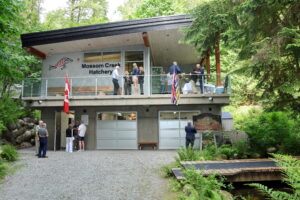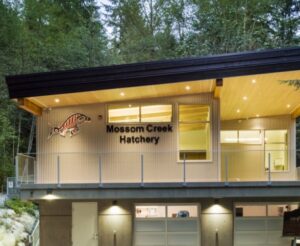Thanks to a generous donation from the Mattson Family, in honour of Jim Mattson, water quality testing and monitoring of Mossom Creek has taken place every Salmon Sunday since October 13, 2019. We also started monitoring North Schoolhouse Creek in early December and are excited about the addition of a new water quality station at our centre.
Jim Mattson was a lifelong environmental steward, extraordinary educator, and honourary lifetime member of Mossom Creek Hatchery. He was instrumental in implementing water quality testing and labs for many creeks in the Port Moody area and we are grateful to have this new equipment at Mossom to continue this work.
Our volunteers collect the water samples as well as use the recently purchased Oxyguard meter to measure dissolved Oxygen in mg/L as well as the temperature of the water on site just above Mossom intake. We do the same for North Schoolhouse Creek just above the culvert under Ioco Road. The water samples are taken back to the Hatchery where we test for dissolved oxygen again but using a different method using the Hach chemical titration kits provided by Pacific Stream Keepers Federation. We also test the pH both by chemical colour test and meter reading, Conductivity, and Total Dissolved Solids are measured using our new Hanna portable meter as well. On occasion, we will test for turbidity using the Turbidity tube and Secchi disks.
In December BIMES also received funding from the PSF of $1500 for the purpose of purchasing a Multiparameter Photometer plus reagents for testing Phosphates, Nitrates and Ammonia, perhaps other factors in the future. We plan to order by mid-January, so perhaps we will start testing these parameters sometime in February.
Aislyn and Aniela plus many other volunteers have helped carry out these tests and everyone is encouraged to participate. It takes about an hour of our time each Sunday and may take longer once we test for the other parameters. It is critical especially at this time when new housing developments, population growth are likely to happen in the not so distant future and climate change is a major factor when water levels are lower and supply is at risk. We, as environmentally conscious individuals and as a community must protect our watersheds and recognize the importance of water quality not only to the health of our salmonids but for the whole biotic community on which they depend.
 Thank you to president Kevin Ryan for organizing an excel spreadsheet for which to record our data. Also, a big thank you to Aislyn Adams, a Chemistry 12 Gleneagle student and Mossom volunteer who spent some of her Christmas holiday time graphing our data so we can see parameter fluctuations in a more visual way. So far, the data shows a healthy Mossom Creek in terms of dissolved Oxygen, pH, conductivity and total dissolved solids and turbidity. However, there is much development slated for the area not far from Mossom and North Schoolhouse Creek in the not too distant future, so it is important to monitor now to compare on any changes that may happen in the future.
Thank you to president Kevin Ryan for organizing an excel spreadsheet for which to record our data. Also, a big thank you to Aislyn Adams, a Chemistry 12 Gleneagle student and Mossom volunteer who spent some of her Christmas holiday time graphing our data so we can see parameter fluctuations in a more visual way. So far, the data shows a healthy Mossom Creek in terms of dissolved Oxygen, pH, conductivity and total dissolved solids and turbidity. However, there is much development slated for the area not far from Mossom and North Schoolhouse Creek in the not too distant future, so it is important to monitor now to compare on any changes that may happen in the future.
In early January our DFO advisor Sandy HK found some old but interesting and detailed studies of Mossom Creek and the feasibility of setting up a hatchery here, dating from 1977 and 1978. The Chemistry or water quality section in 1978 report by Centennial students and teachers really sparked my interest. As Water Quality testing was not available at school they approached Environment Canada Water Quality lab and under the guidance of senior technician John Davidson collected Mossom water samples and had them tested for several parameters including dissolved Oxygen, temperature, pH, Sulphates, Chloride, Fluorides, Phosphates, Ammonia, Nitrites, Nitrates, Silica, Turbidity, Conductivity, metals ( did not mention which ones but below detection levels) and Coliform bacteria.
During one Salmon Sunday, November 10, Aniela, Vicki, Neil, and Jennifer completed the Pacific Stream Keepers Federation PSKF Module 3 Survey on Water Quality on a defined section of Mossom Creek just above the intake. The water quality index (WQI) indicated Mossom’s water quality is good. We had a score of 40.5 and any score between 40 and 45 is good. In early December we submitted our survey data to PSKF.
On November 19th after school, teacher Diether Malakoff brought up 14 students from Centennial Salmon Club, to get a lesson on Water Quality. Jennifer presented a PowerPoint presentation and lesson on the factors that affect water quality and demonstrated the testing procedures of some of these factors. Neil demonstrated measuring the Turbidity using the Turbidity tube and Secchi Disk. They also got a chance to do some of the testing themselves. I really appreciated Neil and Ruth’s help with this learning opportunity and introduction for some new students to find out what Mossom Hatchery is all about.




